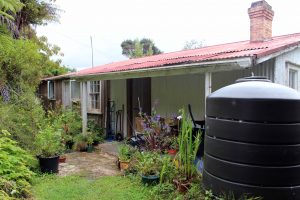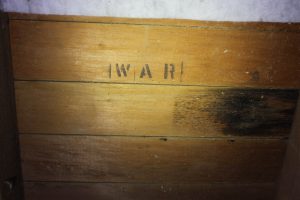
The house at Opua – archaeological research has shown that it was not part of the historic Te Wahapu Barracks.
(Image source Heritage New Zealand
"A house in Opua – widely believed to have been part of historic barracks that were established by colonial troops at Te Wahapu in 1846 – has another story to tell.
“Close inspection of saw marks on the stud timber, however, show that it was cut using a ‘Twin Break Down Saw’. This type of saw did not appear in New Zealand mills until the 1870s – which is a long time after the Te Wahapu Barracks was built. The timber is also kauri which means it was milled in New Zealand. Both factors strongly suggest that the house was not part of the original barracks.”
"The saw marks are a good example of how building archaeology techniques can provide insights into the construction method of historic buildings and their history according to Heritage New Zealand’s Northland Area Manager, Bill Edwards.
The Media Release is as follows:
June 7
MEDIA RELEASE

The mysterious WAR initials on some of the boards in the house – not necessarily a military reference.
(Image sourced Heritage new Zealand)
Heritage ‘detective’ work sheds light on true history of house
A house in Opua – widely believed to have been part of historic barracks that were established by colonial troops at Te Wahapu in 1846 – has another story to tell.
It would seem that rumours of the house being an important part of Northland’s early military heritage are greatly exaggerated thanks to a detailed archaeological survey by local archaeologist Alex Bell of Bell Heritage.
It would also appear that the legend of the barracks may have been connected with an earlier structure which was demolished in the early 20th Century instead, though the story may have been transferred to the existing building in subsequent years.
“The property in Paihia Road near Opua is believed to have been moved here in the late 1860s having formerly been part of the Te Wahapu Barracks across the Bay,” says Alex, who carried out the investigation as part of an archaeological assessment for the owners of the property.
“It’s generally thought that the building came over to the Opua site at the same time as a group of Irish settlers who were making their way to Whangae near Kawakawa to establish a new settlement there. If correct, that would date the movement of the homestead to about 1866.”
Te Wahapu was established by Gilbert Mair when he purchased the land in 1831 and established a trading station and shipyard at the south west corner of the area adjacent to Tore Tore Island. The settlement grew to include a dwelling, store house, American Consul office, various cottages, a blacksmith, boatbuilder’s shop and other amenities that helped make this a bustling community.
During the time of the Northern Wars, Te Wahapu was abandoned by Pakeha and used by Kawiti and Hone Heke as a staging area prior to their attack on Kororareka-Russell. In July 1846, however, 300 colonial troops of the 58th Regiment under the command of Major Cyprian Bridge occupied the settlement. The troops remained there for 11 years as the former civilian village was transformed into a military barracks.
A number of features of the historic house in Opua have pointed to a possible connection with the Te Wahapu barracks – including the stencilled letters ‘WAR’ under a number of the original floorboards.
“The letters are still a mystery, though they’re not necessarily a military reference,” says Alex.
“The letters could be initials referring to the original owner of the building, a company or even a delivery location for example.”
Other evidence contained within the structure of the house is less ambiguous however.
“Saw marks on exposed wood can tell us a lot about the age of a building. Most saw marks on the house were consistent with band saws and circular saws – both of which were in wide use by the 1860s, though very rare in the 1840s,” says Alex.
“Close inspection of saw marks on the stud timber, however, show that it was cut using a ‘Twin Break Down Saw’. This type of saw did not appear in New Zealand mills until the 1870s – which is a long time after the Te Wahapu Barracks was built. The timber is also kauri which means it was milled in New Zealand. Both factors strongly suggest that the house was not part of the original barracks.”
The saw marks are a good example of how building archaeology techniques can provide insights into the construction method of historic buildings and their history according to Heritage New Zealand’s Northland Area Manager, Bill Edwards.
“These techniques enable us to test some of our understanding around some of the history of places like the house at Opua, and see whether or not our assumptions hold water,” says Bill.
“Although not all the questions about the house have been answered, the research indicates that the building is younger than oral tradition has previously indicated; and was not part of the Te Wahapu barracks but probably dates from the 1870s instead.”












Comments are closed.